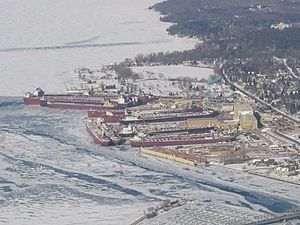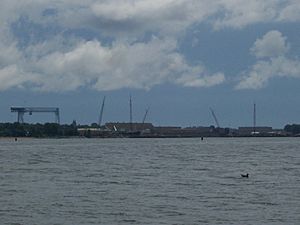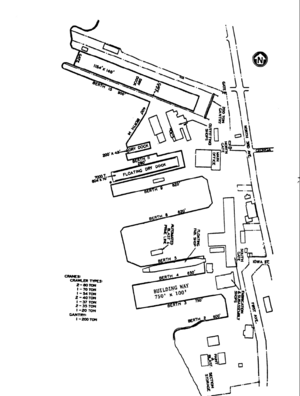Bay Shipbuilding Company facts for kids

Lakers wintering over at Bay Shipbuilding, 2006
|
|
| Industry | Shipbuilding |
|---|---|
| Predecessor | Sturgeon Bay Shipbuilding and Christy Corporation |
| Founded | 1968 (as Bay Shipbuilding) |
| Headquarters | Sturgeon Bay, Door County, Wisconsin |
| Parent | Fincantieri Marine Group (2009-) Manitowoc Company (1968–2008) |
Bay Shipbuilding Company (BSC) is a company that builds and repairs ships. It is located in Sturgeon Bay, Wisconsin.
As of 2015, Bay Ships is part of Fincantieri Marine Group. The company builds special tug-and-barge systems and ships that carry oil safely. They also make vessels that support offshore oil rigs. Bay Shipbuilding also fixes large cargo ships that travel on the Great Lakes.
The company has a long history, going back to 1918. It has operated under different names over the years. In the 1970s and 1980s, Bay Shipbuilding built huge cargo ships called "Lake freighters." These ships could carry up to 40,000 tons.
Even though they could build big freighters, the company did not build one over 20,000 tons after 1987. That changed when the MV Mark W. Barker was launched in 2022.
Some older names for the shipyard in Sturgeon Bay include Sturgeon Bay Shipbuilding, Leathem D. Smith Shipbuilding Company, and Christy Corporation.
Contents
Bay Shipbuilding's Story
How Bay Shipbuilding Started (1968-1979)
Bay Shipbuilding Company began in 1968. This happened after The Manitowoc Company closed its Manitowoc Shipbuilding Company. Manitowoc then bought Sturgeon Bay Shipbuilding. In 1970, they also bought Christy Corporation. These two shipyards were next to each other on the east side of the Sturgeon Bay Ship Canal.
Before becoming part of Bay Shipbuilding, Sturgeon Bay Shipbuilding & Dry Dock had other names. These included Rieboldt, Wolter & Co., Universal Shipbuilding Company, and Sturgeon Bay Dry Dock Company. Christy Corporation also had earlier names. These were Leathem D. Smith Towing & Wrecking Company, Leathem D. Smith Dock Company, and Leathem D. Smith Shipbuilding & Dry Dock Company.
Bay Shipbuilding first spent $500,000 to buy the two shipyards. In the early 1970s, they invested $30 million more to make improvements. The 1970s were a very busy time for Bay Shipbuilding. This was because companies that owned ships on the Great Lakes decided to update their fleets. Bay Shipbuilding built 30 ships for the Great Lakes fleet during the 1970s.
In 1975, Bay Shipbuilding had about 800 workers. They expected to hire more, up to 1,400 people. This was because they won a new contract to build four very long lake freighters. These ships were 1,000 feet long. They were for the American Steamship Company and Bethlehem Steel. At least six of these huge, 1,000-foot-long ships were delivered between 1977 and May 1981. By the end of 1978, Bay Shipbuilding had almost 2,000 employees.
Changes in the 1980s and 1990s
After building new lake freighters slowed down, Bay Shipbuilding started building ships for the ocean. By 1984, the number of workers had dropped to about 220. Later that year, Bay Shipbuilding won a contract. They would build three container ships for Sea-Land Service for about $180 million.
These ships were special because they were the only ones Sea-Land designed and built in the United States. Bay Shipbuilding did not win the contract by being cheaper than foreign shipyards. The ships were going to travel from Puget Sound to Alaska. Because of a law called the Jones Act, ships on this route had to be made in the United States.
In March 1988, after finishing the three Sea-Land container ships, Bay Shipbuilding announced a change. They said they would stop building new ships for a while. This was because there were not enough contracts in the US and the shipbuilding industry was slowing down. In the mid-1990s, another nearby shipyard, Peterson Builders, also closed.
In the late 1990s, the shipyard built a few smaller vessels. These included a ferry, two tugboats, a dredge, and a 475-foot tank barge.
From 2000 to Today

In the 2000s, Bay Shipbuilding continued to build special tank barges. These barges have a double hull for safety, as required by the Oil Pollution Act of 1990. More recently, they have also built Articulated tug and barges and vessels that support offshore oil operations.
The Manitowoc Company sold its marine business, including Bay Shipbuilding, to Fincantieri Marine Group. This sale became official at the end of 2008. Before 2015, Fincantieri invested $26 million to improve the shipyard. They added a new floating dry dock and modern computer-aided manufacturing equipment.
In 2021, the shipyard launched the 639-foot freighter MV Mark W. Barker. This was the first new "laker" (Great Lakes freighter) built by a U.S. shipyard in 40 years. Several other large barges, up to 740 feet long, have also been built here in the 21st Century.
In February 2021, a well-known lake ship, the MV Roger Blough, caught fire. This happened while it was being stored for winter at Bay Shipbuilding. The fire caused a lot of damage to the ship. Luckily, no one was hurt.
On July 1, 2022, the MV Mark W. Barker was floated out of its building dock. It was the first lake freighter built by the yard since 1987. This new freighter started regular service on July 27, 2022. It was officially named on September 1 in Cleveland, Ohio.
Older Shipyards That Became Bay Shipbuilding
Sturgeon Bay Shipbuilding and Dry Dock Company
The Universal Shipbuilding Company and the Sturgeon Bay Dry Dock Company joined together in 1926. They formed the Sturgeon Bay Shipbuilding and Dry Dock Company. This company changed owners in April 1934 and had about 90 workers at that time.
Before World War II, they built fishing boats, tow boats, and ferries. During the war, Sturgeon Bay SB&DDC built many ships for the U.S. Army. These included retrieving vessels, supply boats, and many tugboats.
After the war, Sturgeon Bay SB&DDC continued to build ferries, tugboats, and fishing vessels. Most of these ships were under 100 feet long. By 1949, about 225 people worked there. In the 1950s, they built 20 tugboats for pushing barges on the Mississippi River. In the 1960s, they built many fishing trawlers, about 100 feet long, for the New England fishing industry.
As mentioned earlier, in 1968, the Manitowoc Company bought Sturgeon Bay SB&DDC. It was then renamed Bay Shipbuilding.
Christy Corporation and Its Earlier Names
Christy Corporation was formed right after World War II. It came from Leathem D. Smith Shipbuilding. This company had been known by other names before, such as Leathem D. Smith Towing & Wrecking Company and Leathem D. Smith Shipbuilding & Dry Dock Company.
During World War II, Leathem D. Smith Shipbuilding built many different types of ships. These included cargo ships, submarine chasers, and Tacoma-class frigates. Toward the end of the war, Leathem built ships for laying nets, water tankers, and more cargo ships. During the war, Leathem delivered a new ship about every 20 days. The shipyard had about 5,000 workers during the war.
As Christy Corporation, in the 1950s, the shipyard built the SS Spartan and SS Badger. These were ferries that traveled between Wisconsin and Michigan. They also built tank landing ships and Landing Craft Utility ships for the US Navy.
In the 1960s, Christy built a variety of different ship types. These included research ships like USNS James M. Gilliss (T-AGOR-4) and USNS Charles H. Davis (T-AGOR-5). They also built the ferry MV Tustumena, the research vessel NOAAS David Starr Jordan (R 444), and the Coast Guard cutter USCGC Active (WMEC-618).
As mentioned before, in 1970, the Manitowoc Company bought Christy Corporation's shipyard. It was then combined with Bay Shipbuilding.
See also
- Marinette Marine, another company owned by Fincantieri Marine Group.
- Manitowoc Shipbuilding Company, a company closed by The Manitowoc Company to help create Bay Shipbuilding.
- Fraser Shipyards, another large shipyard on the Great Lakes.


